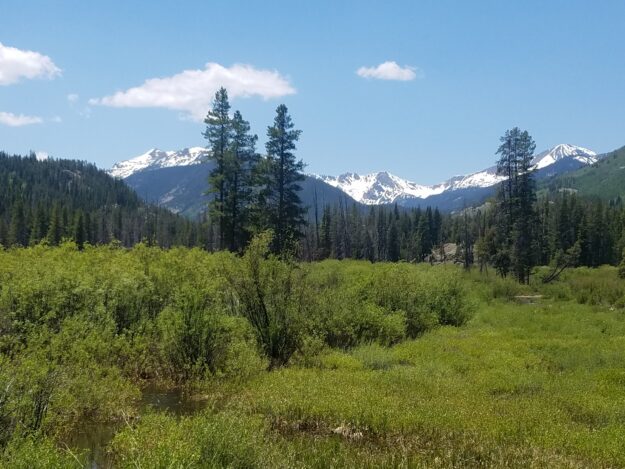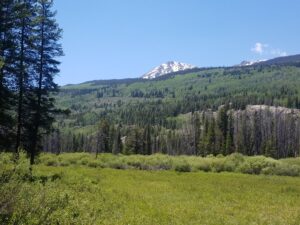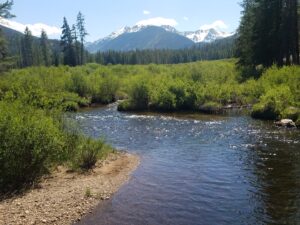Widgetized Section
Go to Admin » Appearance » Widgets » and move Gabfire Widget: Social into that MastheadOverlay zone
Eagle County 1041 authority looms large in proposed Whitney Reservoir debate as feds slash more regs

With Wednesday’s move by the Trump administration to weaken one of the nation’s bedrock conservation laws – the National Environmental Policy Act (NEPA) – all eyes will increasingly be on local opposition and regulation when it comes to major infrastructure on federal lands.

That’s pretty much what Eagle County Commissioner Kathy Chandler-Henry told me when I asked about the proposed Whitney Reservoir project currently being scoped out by the U.S. Forest Service along Homestake Creek in southeastern Eagle County. The reservoir is being proposed by Colorado Springs and Aurora to pump Western Slope water to the Front Range.
All that’s currently being considered by the Forest Service is a test-drilling project to detect fatal flaws and see if one of four possible dam configurations is feasible, at which point an actual proposal for Whitney Reservoir would be submitted and considered by the feds, including a possible request to shrink the Holy Cross Wilderness by up to 500 acres to realign the road.
The Forest Service was flooded with more than 500 online comments opposing the drilling and the reservoir, demanding higher levels of environmental scrutiny for a special use permit for the drilling project that could be issued under what’s known as a “categorical exclusion.” Opponents are demanding an Environmental Assessment (EA) or Environmental Impact Statement (EIS).
Much of that debate was covered in an article I produced for Aspen Journalism that ran in the Vail Daily on July 9 and then talked about on Krystal 93 radio out of Summit County on July 10. I first wrote about the drilling proposal on June 23 after the Forest Service issued a press release requesting comments on June 1. Aspen Journalism first broke the story way back in July of 2019.
What didn’t make it into my Vail Daily story due to space constraints was the Eagle County angle. It’s important because way back in the 1990s, when I first moved to the Vail area, there was a huge battle going on over what was then called Homestake II – a water diversion proposed for the same area by the same cities, which still hold 20,000 acre-feet of water rights here.
Eagle County used its 1041 permitting powers, which give counties some degree of local control over infrastructure projects with regional or statewide impacts, to deny Homestake II – a move that wound up in court and went all the way to the Colorado Supreme Court before Eagle County ultimately won. Those 1041 regulatory powers were granted by a state law in the 1970s.
All of that led to the Eagle River Memorandum of Understanding (MOU) that outlines how all the various stakeholders in the Eagle River Basin would work together going forward to resolve their issues. But one important thing remains true: Eagle County, not a signatory to the MOU, still has 1041 permitting authority.
So Chandler-Henry, the water leader on the board, had some important things to say last spring. First, on any proposal that would require redrawing the boundaries of the Holy Cross Wilderness Area: “I can tell you that’s not anything that we would ever be supportive of is moving wilderness boundaries.” Then, on the importance of local permitting power:

Chandler-Henry points out that federal protections have been stripped away by the current administration, with fens and ephemeral streams recently being removed from the definition of Waters of the United States by the U.S. Environmental Protection Agency. Those changes, she said, are making it much easier for water providers to get their federal permits in place.
“Which means 1041 is all the more important for local considerations,” Chandler-Henry said, adding she believes her constituents oppose a dam. “I think that that is going to be a huge public sentiment, that we don’t want anything there.”
That being said, the county has to be somewhat diplomatic on both the test drilling and a possible future reservoir. Eagle County officials said they are working with the Forest Service on the test drilling proposal and may comment later.
“Eagle County cannot take a position regarding, and will not be commenting on, any future reservoir project because of its permitting authority powers,” county officials said in an email. “Eagle County must avoid prejudging a file based upon this authority.
“Eagle County plans to meet with the USDA USFS to discuss procedural questions regarding the proposed Whitney Creek Geotechnical Investigation project. Depending upon the outcome of that conversation, Eagle County may or may not choose to provide comment [to the Forest Service],” officials added.
Chandler-Henry, who talked to me well before the formal test drilling application and the recent Trump move to gut NEPA, said the county is keeping an open mind on 1041 permitting for whatever proposal eventually comes before the board. However, she reiterated that shrinking the Holy Cross boundary – something Congress would have to approve – is a non-starter.
“Sen. [Michael] Bennett’s office says that whenever they’re approached by Aurora Water about moving those boundaries in Holy Cross, they say, ‘You need to go see what Eagle County thinks.’” Chandler-Henry added. “To date they have not done that because I think they know what we think about that.”
An official with Bennet’s office confirmed they are aware of the wilderness adjustment plan but are not supportive of pulling back boundaries to make room for a proposed reservoir because there is not broad local backing. Bennet has been a strong advocate of wilderness expansion, not shrinkage.
U.S. Rep. Joe Neguse, the Democrat whose district includes the eastern third of Eagle County, was the lead House sponsor of the Colorado Outdoor Recreation Economy (CORE) Act that passed in the Democrat-controlled House last fall but has yet to be taken up in the GOP-controlled Senate. The bill protects 400,000 acres of Colorado’s public lands, including 73,000 acres of new wilderness.
“Congressman Neguse is concerned about the impacts this wilderness proposal would have on the environment and the surrounding wetlands,” Neguse spokeswoman Sally Tucker wrote in an email. “Local input for wilderness designations is crucial and local authorities must be included in these ongoing conversations.”
Conservation groups see this as a key issue, linking the test drilling to an eventual dam proposal that could lead to less wilderness. The original Homestake II proposal would have been in the Holy Cross Wilderness Area.
“That’s number one is how are you going to shave that [wilderness] boundary?” said Jerry Mallett, president of Colorado Headwaters, an environmental group based in Salida. “That’s going to have to go to Congress. The Boulder congressman whose district it’s in [Neguse] has said no way in hell is he going to support it.”
Mallett has been distributing a quote from Neguse opposing the proposal, but a Neguse spokeswoman would not confirm its authenticity.
Chandler-Henry said Eagle County is firm on the wilderness issue but staying openminded on 1041 so any proposal can be weighed fairly on its merits.
“One of the things that we’re doing, which is going to be really useful, is trying to tie our 1041 permitting in with the community water plan that [Eagle River Watershed Council] is working on … because a 1041 allows us to look at environmental impact, economic impact, infrastructure,” Chandler-Henry said, adding the utility has been modeling for future growth.
“Those are always our concerns with any sort of 1041 permit,” Chandler-Henry added. “What happens if water is dammed up in a reservoir? Then what happens to the Eagle River, to the environment, to the subdivisions that are relying on that water, to the recreation economy?”
Chandler-Henry said Aurora Water has been a part of that planning process.
Here’s an early version of a story RealVail.com produced for Aspen Journalism. A version edited for space ran in the Vail Daily on July 9, so this longer version may be a bit repetitive.
I cannot express strongly enough how vital the nonprofit Aspen Journalism has been in first reporting on this important story in 2019 and in funding the follow-up story in the Vail Daily; please consider donating.
Forest Service flooded with comments opposing Whitney Reservoir
RED CLIFF — The U.S. Forest Service has been inundated with more than 500 online comments in opposition to a geotechnical and drilling study by the cities of Aurora and Colorado Springs to determine the feasibility of a second reservoir in the Homestake Creek drainage six miles southwest of Red Cliff, including objections from nearby towns and a local state senator.
The mayors of Red Cliff and Minturn signed and submitted an identical letter questioning the legality of drilling 10 boreholes on Forest Service land near the Holy Cross Wilderness Area to see if soil and bedrock can support a dam for what would be known as Whitney Reservoir. Avon’s attorney has asked for a public comment extension to Aug. 4 so it can hold a hearing.

“A Whitney Reservoir would irreparably change and harm our community,” Minturn Mayor John Widerman and Red Cliff Mayor Duke Gerber wrote in letters submitted June 30. “We are paying close attention to these proposals, other moves by Homestake Partners, and the public controversy. This categorical exclusion is rushed, harmful and unlawful.”
Operating together as Homestake Partners, Aurora and Colorado Springs own water rights dating back to the 1950s that, under the 1998 Eagle River Memorandum of Understanding (MOU), ensure them 20,000 more acre-feet of average annual water yield. They’ve been studying four potential dam sites in the Homestake Valley several miles below the cities’ existing Homestake Reservoir, which holds 43,600 acre-feet.
The smallest configuration of Whitney Reservoir, if it’s deemed feasible and ultimately approved, would be 6,850 acre-feet, and the largest would be an up to 20,000-acre-foot reservoir on lower Homestake Creek that would pump water up to Homestake Reservoir about five miles upstream, then over the Continental Divide to Turquoise Reservoir near Leadville on the Eastern Slope.
Western Slope signatories of the Eagle River MOU were tight-lipped on the geophysical study and drilling. Jim Pokrandt, director of community affairs for the Colorado River District, declined to comment on the investigatory test work, saying only, “Yes, we have signed the MOU. That said … we are not participating in the Whitney Creek effort.”
Diane Johnson,communications and public affairs manager for the Eagle River Water & Sanitation District, said: “The short answer is we – [ERWSD] and Upper Eagle Regional Water Authority — support [Homestake Partners’] right to pursue an application for their yield. We trust the permitting process to bring all impacts and benefits to light for the community to consider and weigh in total.” Neither organization submitted a comment to the Forest Service.
Many of the 520 online comments as of the June 30 deadline objected to even testing for the possibility of a dam – expressing concern for the complex wetlands in the area — but most also strongly condemn a future Whitney Reservoir. The cities are trying to keep the focus on testing.
“This is simply a fatal-flaw reservoir siting study that includes subsurface exploration, and it’s basically just to evaluate feasibility of a dam construction on lower Homestake Creek,” said Maria Pastore, Colorado Springs Utilities’ senior project manager for water resource planning. “It’s simple exploratory work to determine if we can even go ahead with permitting and design.”
Whitney Reservoir, which would also require a 1041 permit from Eagle County, has not been formally proposed to the Forest Service. Versions of the project would require an up to a 497-acre reduction of the Holy Cross Wilderness Area for reconfiguring Homestake Road (703), and that could only happen with an act of Congress and the signature of the president.
“The reservoir concept has not been proposed nor is it under analysis by the Forest Service at this time,” Marcia Gilles, acting ranger for the Eagle-Holy Cross District, said in an email. “Any future proposal to develop a reservoir will require a separate application by the proponent and a separate environmental analysis by the Forest Service ….”
Gilles, who said her office will continue accepting comments at any time during the ongoing analysis of the geophysical study despite the June 30 deadline, added that if the Forest Service concludes there are no “extraordinary circumstances,” she can render a decision using what’s known as a categorical exclusion and then issue a special use permit as soon as August. A categorical exclusion requires less environmental scrutiny than other forms of analysis.

“At this time, the proposed action appears to be categorically excluded from requiring further analysis and documentation in an Environmental Assessment (EA) or Environmental Impact Statement (EIS),” Gilles said. “Should the environmental analysis find extraordinary circumstances, the Forest Service would proceed to analyzing the project in an EA or EIS.”
State Sen. Kerry Donovan, a Vail Democrat, wrote to the Forest Service on June 30: “I … strongly urge you not to categorically exclude this project from NEPA [National Environmental Policy Act] analysis. I cannot express how sternly the citizens of my district [which encompasses seven Western Slope counties, including Eagle, where the dam would be located] oppose water diversion projects to Front Range communities.”
Donovan called the proposed investigation itself, which would require temporary roads, heavy drilling equipment, continuous high-decibel noise, driving through Homestake Creek and use of its water in the drilling process, “an afront to the Keep it Public movement.”
Impacts from fatal-flaw drilling
If approved by the Forest Service for a special use permit, Homestake Partners would send in crews on foot to collect seismic and other geophysical data later this summer or fall. Then crews with heavy equipment would drill 10 bore holes of up 150 feet deep in three separate possible dam locations on Forest Service land.
Crews would use a standard pickup truck, a heavy-duty pickup pulling a flatbed trailer, and a semi-tractor and trailer that would remain on designated roads and parking areas, with some lane closures of Homestake Road (703) and dispersed campsites possible.
For off-road boring operations, crews would use a rubber-tracked drill rig, a utility vehicle (UTV) pulling a small trailer, and a track-mounted skid steer. The drill rigs are up to 8 feet wide, 22 feet long, and 8 feet high and can extend up to 30 feet high during drilling, requiring possible tree removal in some areas. The rigs would also have to cross Homestake Creek and some wetland areas, although crews would use temporary ramps or wood mats to mitigate impacts.
According to a technical report (pdf) filed by Homestake Partners, the subsurface work is expected to take up to five days per drilling location, or at least 50 days of daytime work only. However, continuous daytime noise from the drilling could approach 100 decibels, which is equivalent to an outboard motor, garbage truck, jackhammer or jet flyover at 1,000 feet. If work is not done by winter, crews have up to a year to complete the project and could return in 2021.
The drilling process would use several thousand gallons of Homestake Creek water per day that engineers say “would have negligible impacts on streamflow or aquatic habitat. Water pumped from Homestake Creek during drilling would amount to less than 0.01 [cubic feet per second], a small fraction of average flows.”
Homestake Partners would avoid wetlands as much as possible during drilling, but “where temporary wetland or waters disturbance is unavoidable, applicable 404 permitting would be secured from the U.S. Army Corps of Engineers (Corps).” Crossing of Homestake Creek would occur in late summer or fall when stream flows are low, and no drilling would occur in wetlands.
While no permanent roads would be built for the drilling, temporary access routes would be necessary and reclaimed as much as possible. “Access routes would be selected to reduce surface disturbance and vegetation removal, and to avoid identified or potential unexploded ordnances (UXOs) discovered during field surveys.” The famed 10th Mountain Division of the U.S. Army used the area for winter warfare training during World War II.
Listed as threatened under the Endangered Species Act, “only Canada lynx has potential habitat in the vicinity of the project area,” according to the technical reports on the project. “No impacts on lynx are anticipated from the proposed work because much of the activity would occur near Homestake Road, a well-traveled recreation access road. Work would be conducted over a short period (approximately five to six weeks) and impacts on potential habitat would be negligible.”
The vast majority of comments from a variety of environmental groups and concerned citizens focused on potential impacts to wetlands and peat-forming fens in the area, which the project proponents say they will avoid as much as possible. So far, Gilles said she is not aware of any legal challenges to the project.
Two prominent local conservation groups – the Eagle Valley Land Trust and the Eagle River Watershed Council – both submitted comments to the Forest Service expressing serious reservations about both the drilling and the possibility of a dam.
“Geophysical exploration has an obvious significant nexus and direct relation to additional future actions, i.e., dam construction, which may in time massively impact the Eagle River watershed – regardless of whether the future actions are yet ripe for decisions,” ERWC officials wrote.
Eagle County officials said they are working with the Forest Service and may comment later.
“Eagle County cannot take a position regarding, and will not be commenting on, any future reservoir project because of its permitting authority powers,” county officials said in an email. “Eagle County must avoid prejudging a file based upon this authority.
“Eagle County plans to meet with the USDA USFS to discuss procedural questions regarding the proposed Whitney Creek Geotechnical Investigation project. Depending upon the outcome of that conversation, Eagle County may or may not choose to provide comment,” officials added.
Aurora officials said that no siting decisions have been made and this proposal is just a test.
“If I could stress one thing, it would be that we haven’t chosen an alternative; we’re still assessing,” said Kathy Kitzmann, water resources principal at Aurora Water, adding that the cities are fully focused on “minimizing the environmental impacts of our project as we go forward, but that’s part of the objective of the Eagle River MOU, and we recognize that the quality of life involves both sides of the [Continental] Divide.”
Eagle River MOU
The Eagle River MOU was drawn up after a lengthy court battle that ended in the 1990s when Eagle County rejected the cities’ Homestake II diversion proposal using its 1041 powers under a state law passed in the 1970s that gives counties permit authority over certain outside infrastructure projects that could impact the local economy and environment.
Besides Homestake Partners (the two cities), the MOU was signed by the Colorado River District, Climax Molybdenum Company, and the Vail Consortium consisting of the Eagle River Water and Sanitation District, Upper Eagle Regional Water Authority and Vail Associates (now Vail Resorts).
The two private companies signed onto the MOU – Vail Resorts and Freeport-McMoRan (Climax) – declined to comment on either the drilling study or Whitney Reservoir.
Any proposed water project by any of the signatories has to meet the objectives of the MOU, which are, “Develop a joint use water project in Upper Eagle River basin that minimizes environmental impacts, is cost-effective, technically feasible, can be permitted by local, state and federal agencies, and provides sufficient yield to meet the water requirements of project participants as hereinafter defined.”
ERWSD’s Johnson said the water provider can’t comment on Whitney Reservoir because its environmental impacts have yet to be defined, but she did have overall praise for the MOU.
“To date, water users in the Eagle River basin have received great benefits from the MOU,” Johnson said. “It has been the basis to develop key elements of the local municipal and snowmaking water supplies that have been essential to the economic vitality of our community.”
The MOU provides 20,000 acre-feet for the cities, 10,000 acre-feet of firm water yield for the Vail Consortium (meaning if there’s a shortage, those needs are met first), and 3,000 acre-feet of water storage for Climax. About 2,000 acre-feet were already developed with Eagle Park Reservoir, but that leaves 28,000 acre-feet of yield and 3,000 of storage undeveloped.
An acre-foot is enough to cover one acre of land — about the size of a football field — one foot deep in water. Aurora Water says one acre-foot can supply about three homes in its city for a year.
The Whitney Reservoir alternatives range from 6,850 to 20,000 acre-feet and in some configurations would require federal legislation, which the cities are working to draft, requesting a boundary adjustment for the nearby Holy Cross Wilderness Area. The largest Whitney proposal would require an 80-acre adjustment, while an alternative location lower down Homestake Creek, known as Blodgett Dam, would require a 497-acre adjustment.
White River National Forest Supervisor Scott Fitzwilliams discounts the notion that his agency should outright reject the test drilling application, as some environmental groups have suggested, until the wilderness boundary issue is determined.
“These are test holes,” Fitzwilliams said of the drilling, which is intended to see if the substrata are solid enough for a dam and reservoir. “Going to get a [wilderness] boundary change is not a small deal for them, so why would you do it if you find fatal flaws? That’s a red herring.”
In an interview last spring, Fitzwilliams said a categorical exclusion seemed appropriate for the drilling application, requiring a less-stringent environmental analysis while still closely monitoring it. As for the actual dam proposal, he won’t even consider it until the wilderness issue is worked out.
“I can’t even look at a proposal of a dam that inundates wilderness because I don’t have the authority to do that and I don’t even have the authority to comment on a wilderness area boundary adjustment,” Fitzwilliams said, adding he expects there will be strong public sentiment against another dam on Homestake Creek.
“I understand it; nobody wants to see a dam in the Homestake drainage. I get that,” Fitzwilliams said. “But it just seems prudent to do [the drilling] to see if there’s any reason to go further.”
In 2018, Aurora Water paid $4.1 million for 150 acres of private land in the area, which it leases back to the former owner for a nominal fee. That land, which would be inundated to accommodate a large portion of Whitney Reservoir’s surface area, is braided with streams, waterfalls and lush with fens and other wetlands. It’s also home to a 10th Mountain Division cabin once used as an officers’ quarters.
Eagle County 1041 powers
Eagle County Commissioner Kathy Chandler-Henry said her board is keeping an open mind on 1041 permitting, which gives the county some degree of local control over infrastructure projects with regional or statewide impacts, and is willing to fairly assess whatever proposal Homestake Partners eventually submits. But, she added, “I can tell you that’s not anything that we would ever be supportive of is moving wilderness boundaries.
“Sen. [Michael] Bennet’s office says that whenever they’re approached by Aurora Water about moving those boundaries in Holy Cross, they say, ‘You need to go see what Eagle County thinks.’” Chandler-Henry added. “To date they have not done that because I think they know what we think about that.”
An official with Bennet’s office confirmed they are aware of the wilderness adjustment plan but are not supportive of pulling back boundaries to make room for a proposed reservoir because there is not broad local backing. Bennet has been a strong advocate of wilderness expansion.
U.S. Rep. Joe Neguse, the Democrat whose district includes the eastern third of Eagle County, was the lead House sponsor of the Colorado Outdoor Recreation Economy (CORE) Act that passed in the Democrat-controlled House last fall but has yet to be taken up in the GOP-controlled Senate. The bill protects 400,000 acres of Colorado’s public lands, including 73,000 acres of new wilderness.
“Congressman Neguse is concerned about the impacts this wilderness proposal would have on the environment and the surrounding wetlands,” Neguse spokeswoman Sally Tucker wrote in an email. “Local input for wilderness designations is crucial and local authorities must be included in these ongoing conversations.”
Conservation groups also see wilderness as a key issue going forward.
“That’s number one is how are you going to shave that [wilderness] boundary?” said Jerry Mallett, president of Colorado Headwaters, an environmental group based in Salida that formally opposes the drilling and the reservoir. “That’s going to have to go to Congress. The Boulder congressman whose district it’s in [Neguse] has said no way in hell is he going to support it.”
Chandler-Henry said Eagle County is firm on the wilderness issue but staying openminded on 1041 so any proposal can be weighed fairly on its merits. She adds that Eagle County is trying to tie its 1041 permitting in with the community water plan that the Eagle River Watershed Council and several other local and state water groups are working on, including Aurora Water’s Kitzmann, because 1041 allows counties to look at environmental, economic and infrastructure impact. The plan includes water modeling being conducted by ERWSD.
“Those are always our concerns with any sort of 1041 permit,” Chandler-Henry added. “What happens if water is dammed up in a reservoir? Then what happens to the Eagle River, to the environment, to the subdivisions that are relying on that water, to the recreation economy?”
Potential future litigation
Mallett said his group has been working with Save the Colorado and other groups and will likely litigate, either on the drilling or the actual dam proposal or both.
“We know it’s going to be a train wreck; it goes to court either way,” Mallett said. “I’m sure that there will be a lawsuit on the core drilling. Along with the wilderness boundary, the fen is also a hard issue. Homestake is the line in the sand. No more transmountain diversions.”
He also argues much has changed since the two Front Range cities first acquired water rights on the Western Slope back in the ‘50s, with multiple studies showing steadily decreasing flows in the Colorado River.
“Back in 1952 when Colorado Springs and Aurora got that water right, the wilderness wasn’t there and wetlands at that time were something we were just filling in [for construction],” Mallett said, “And they’ve become an extremely valuable resource because of what they can do for groundwater recharge, addressing climate change, all kinds of things.”
Other conservation groups aren’t quite as concerned, at least about the initial testing.
“Right now, I have no real problem with Aurora’s geophysical work, so long as they stay out of wetlands and fens,” said Ken Neubecker, the Glenwood Springs-based Colorado projects director for American Rivers. “As for the reservoir itself, that all depends on the footprint, impacts and operations.”
Neubecker adds that climate change and drought contingency planning all need to be taken into account in the ultimate proposals that may stem from the testing but that those conditions can’t change the fact that Homestake Partners holds water rights dating back to the 1950s. This will be a very long and deliberative process, he adds, so there is no need for “panic action” on the legal front at this time.
“I’m leery of the proposal as well, but after working with Front Range folks for the last 20 years, I’ve seen a considerable change on their part — a willingness to work seriously with West Slope interests and needs. That’s why I’m somewhat cautiously optimistic,” Neubecker said. “Still, I’ll wait and see what they propose.”
Chandler-Henry points out that federal protections have been stripped away by the current administration, with fens and ephemeral streams recently being removed from the definition of Waters of the United States by the U.S. Environmental Protection Agency. Those changes, she said, are making it much easier for water providers to get their federal permits in place.
“Which means 1041 is all the more important for local considerations,” Chandler-Henry said, adding she believes her constituents oppose a dam. “I think that that is going to be a huge public sentiment, that we don’t want anything there.”
Aspen Journalism is a local, nonprofit, investigative news organization that collaborates with the Vail Daily and other Swift Communications newspapers on coverage of water and rivers. For more go to aspenjournalism.org.
David O. Williams
Latest posts by David O. Williams (see all)
- First ever Habitat for Humanity homes craned into Vail as ski town tries to tackle acute housing crisis - July 9, 2025
- ‘Now we have to look at that’, Colorado AG Weiser says of challenging Trump’s energy emergency - July 8, 2025
- Neguse, Bennet call for halt to BLM emergency rule aimed at increasing Utah oil-train traffic - June 23, 2025


